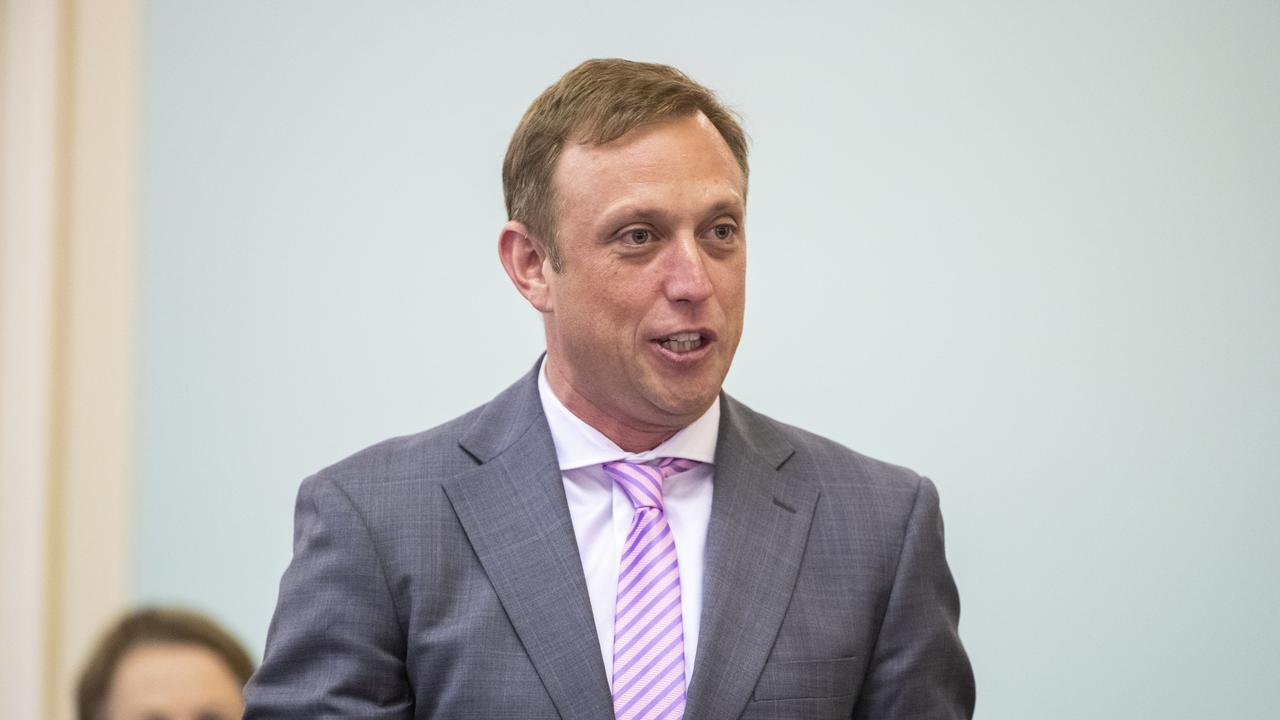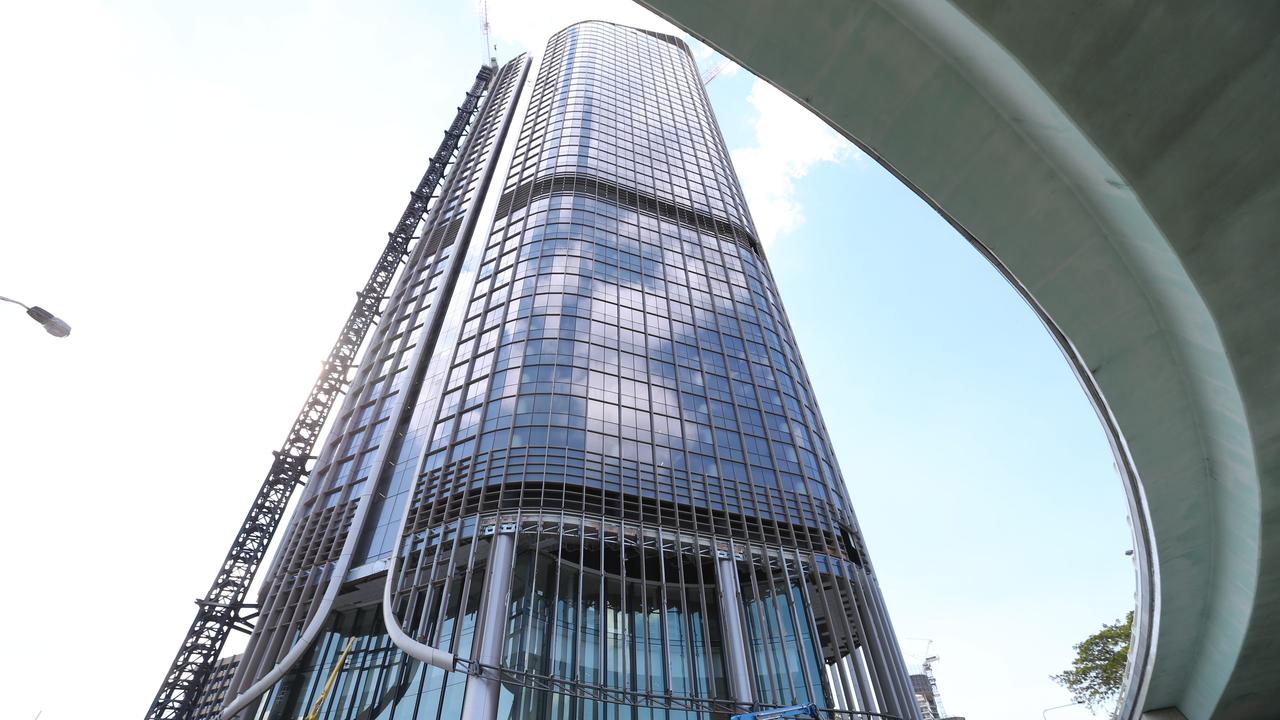Maternity ward closures putting bush babies at risk
A SUMMIT of experts will assess maternity services in the rural and remote parts of Queensland, the health minister has announced in the wake of The Sunday Mail revelation that newborns were dying at a higher rate in the state’s country towns.
QLD Politics
Don't miss out on the headlines from QLD Politics. Followed categories will be added to My News.
A SPECIAL summit of experts will assess maternity services in the rural and remote parts of Queensland, the health minister has announced.
It comes after The Sunday-Mail today revealed that newborn babies were dying at a higher rate in Queensland country towns with no maternity services.
Minister Steven Miles said Queensland Health would convene the summit however assured Queenslanders that birthing was safe.
“Queensland is one of the safest places in Australia, and Australia is one of the safest places in the word, to give birth,” he said.
“But the death of even one mother or baby in childbirth is a tragedy and we continue to look at ways to improve.
“I’ve asked the Department of Health to establish a summit, including reconvening an expert panel formed in 2014 to look at these issues.
“The decision on how to provide the best and safest maternity services for Queensland families is rightly made by local Hospital and Health Services.”

MATERNITY CLOSURES PUT NEWBORNS AT RISK
OVERNIGHT: Newborn babies are dying at a higher rate in Queensland country towns with no maternity services, an alarming investigation into the state’s rural maternity services has found.
Rural doctors say the closure of 40 country obstetric units across the state is forcing desperate mums to either deliver their babies at home with no medical support or to risk a roadside birth by driving hundreds of kilometres to the nearest hospital.
New, previously unreleased data has also found the death rate of babies in towns with no birthing services is almost four times as high as the rate for babies in rural areas with obstetrics.
Amid community uproar over the axing of birthing centres like Theodore and fears that hubs like Chinchilla are balancing on a knife edge, an investigation by The Sunday Mail has discovered the lack of services has reached crisis point.
●40 maternity units have closed over a few decades.
●A rate of 23.3 babies in every 1000 are dying in towns where no birthing services are available, compared to 6.1 babies in rural areas with obstetrics.
●Queensland has the highest rate of free-birthing (without a registered midwife) in the nation.
●Home births, which are monitored by a midwife, have risen.
●More than one child every day is born before arriving at hospital, often at the side of roads, in a problem which has been escalating since 1995.
●Pregnant mums are now travelling up to 600km to give birth, or being forced to spend weeks away from their family in paid accommodation.
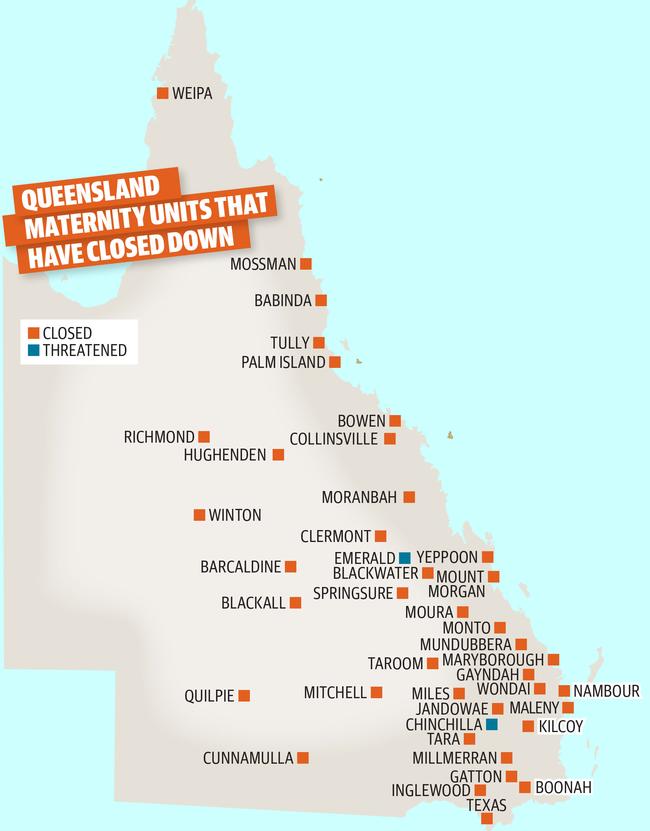
The Sunday Mail yesterday detailed the findings of its investigation to Health Minister Steven Miles.
The Minister is deeply concerned by the findings and it is understood he will today announce an urgent reconvening of a Queensland Health taskforce into the state’s peri-natal and infant mortality rate.
“Any death of a child or a mother in childbirth is tragic. And that’s what sits behind these tragic statistics – lives lost. I’m saddened to see this data,” he said last night.
The Rural Doctors Association Queensland say desperate mums in some towns are resorting to high-risk, 19th century-style “free-birthing” after being backed into a corner.
With the help of Queensland Health’s Perinatal Data Collection agency, the RDAQ has compared peri-natal death rates and doctors are appalled by the number of baby deaths in towns without obstetrics. In these towns, hospitals have limited capacity to deliver unexpected babies or to assist when newborns arrive prematurely or need urgent care.
“Women are left with very poor choices – leave your life and kids behind for a couple of weeks or take the chance of doing it alone,’’ RDAQ vice-president Dr John Hall, a GP and obstetrician in Oakey, told The Sunday Mail.
“Some deem the latter a safer and cheaper option. But the fact that more babies are dying in these areas is simply not acceptable.’’
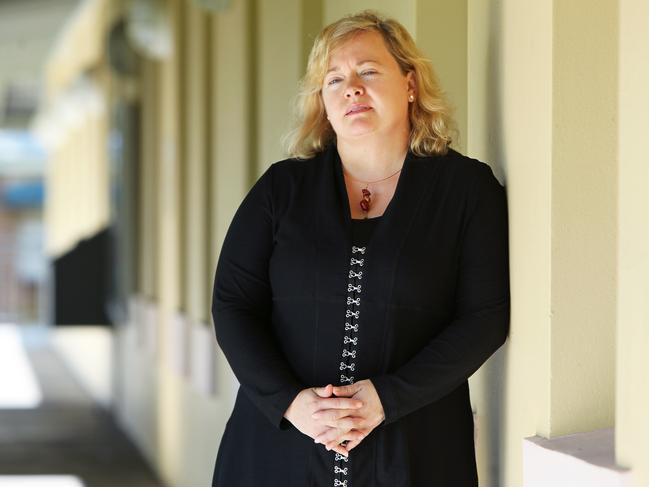
Professor Hannah Dahlen, of Western Sydney University, who has completed extensive research into births before arrival (BBA) and free birthing, said a soon-to-be released study would show more Queensland women opt for “free birthing’’ than women in any other state.
“Our team’s research has shown one of main reasons for free birthing was the lack of access to nearby services or previous trauma in the mainstream system,” Professor Dahlen said.
She said the system was forcing women to be secretive as they were fearful of reports that mothers were being referred to the Department of Children’s Services for not leaving home early enough to stay near central birthing centres.
“We see that some babies have been born and not registered and their existence only comes to the surface when they turn school age,’’ she said.
University of Queensland midwifery professor Sue Kildea said her research had found that the number of BBA leapt by 206 per cent in the two decades to 2011, and was linked to an almost 30 per cent reduction in maternity services in that same period.
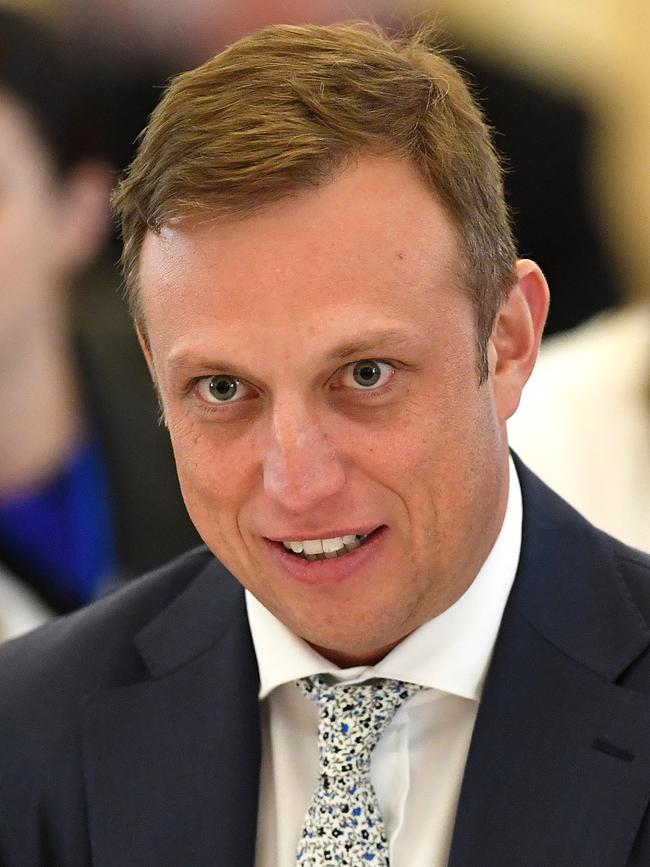
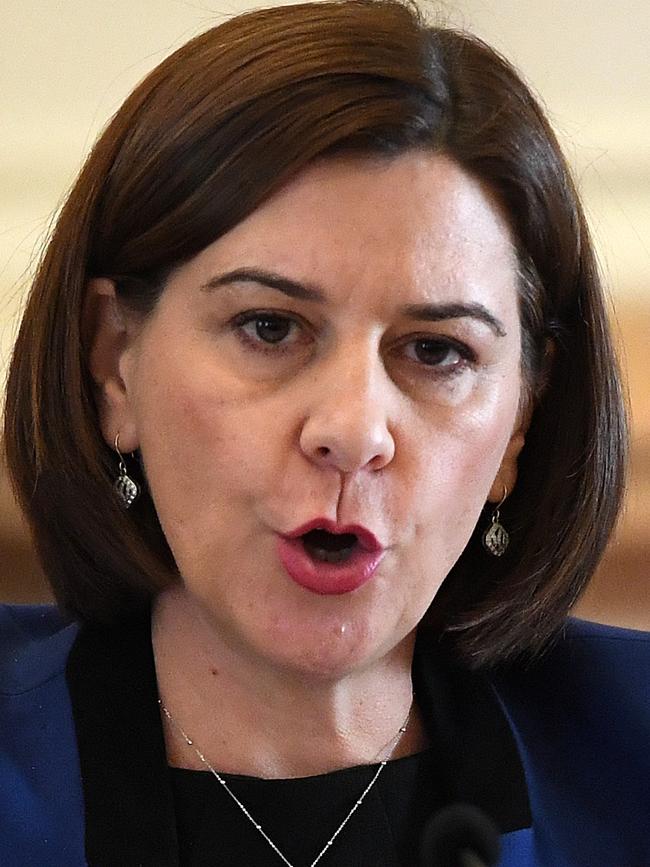
The state’s BBA growth far outstrips the national rise of 47 per cent in the same period.
In 2016 there were eight BBA births in every 1000, compared to seven per 1000 in 2011.
The number of Queensland homebirths, with a professional attending, also rose from 115 in 2015 to 161 in 2016.
“There is an unequivocal relationship between distance to maternity services and poorer clinical and psychosocial outcomes,’’ Professor Kildea said.
Dr Michael Rice from the RDAQ said maternity units in Queensland had been closing down at a rate of three per year in recent years.
Queensland Health deputy director general of Clinical Excellence, John Wakefield, said: “We understand everyone would like every facility or service right there in their own community but safe, specialist birthing services need specialist facilities and enough births to support accredited teams of clinicians,’’ Dr Wakefield said.
Opposition Leader Deb Frecklington said closing maternity services was “treating regional Queenslanders like second-class citizens’’.
POSSIBLE SOLUTIONS
● Strengthen program to train bush GP obstetricians and anaesthetists
● Investment in rural training for nurses and midwives
● Better pay and incentives for nurses and midwives to work in rural areas
● Quarantine funding for rural birthing units
● Maximise access to Medicare and loaded rates for rural doctors, midwives, nurse practitioners and clinics supporting birthing
● Stop closing birthing units when access to caesarean section goes
● Funding for small birth centres
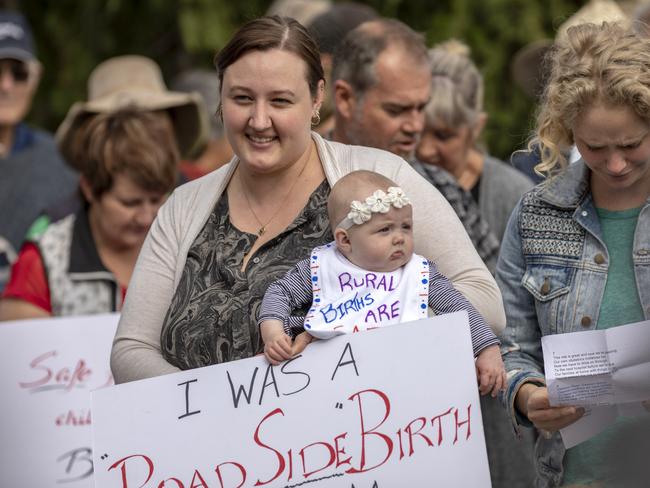
MUM TELLS OF FRIGHTENING BIRTH IN CAR
ZACHARY Curtis wasn’t born in the shiny, state of the art maternity unit in his home town but in the front passenger seat of a Nissan Navara ute.
The baby boy is just one of the rising number of Queenslanders delivered by the roadside.
His family live in Theodore in central Queensland.
In 2010, the residents of the town in tough times dug deep and raised money to rebuild the local hospital’s maternity ward, which was wiped out in the floods.
There was a grand opening but services were cut and the unit began operating only for emergency deliveries.
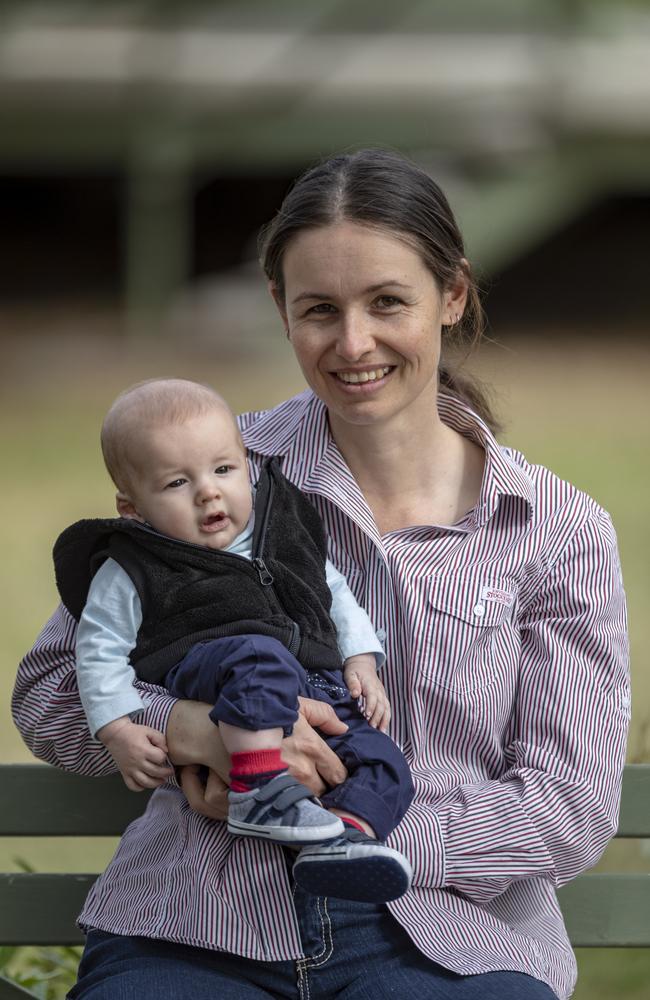
Ellen Nichols, like many other heavily pregnant women, had to leave the comfort of her home, get in the car and travel for hundreds of kilometres to alternative birthing facilities.
“I decided to have the baby in Woodford where my mother lives so I would have support and also would not have to pay for accommodation. It was terrible leaving my own community. I had attended antenatal care in Theodore with the wonderful Dr Bruce Chater. I felt safe there,” Ms Nichols said.
But the arrival of a baby is not always predictable and Zachary was delivered by his grandmother in a car park in Woodford.
“It was cold and the pain was intense but I think adrenaline got me through. Thankfully, there was an ambulance station close by. It was frightening for me and mum and, luckily, everything turned out well,” she said.
“I just cannot understand why I couldn't have my baby at home when everything I needed was already there – wonderful facilities, doctor and midwives.”
MERCY DASH AFTER EXAMINATION
WHAT should have been a simple, natural birth for Chinchilla couple Steve and Ursula Keating turned into a medical emergency, with a lack of resources forcing the town’s maternity unit to be put on bypass to Dalby.
In March the couple (pictured with son Andrew) attended the hospital in Chinchilla, 300km northwest of Brisbane, after Mrs Keating’s waters had partially broken, to find out if they should start making their way to Dalby, 80km away.
“We went to the hospital as a bit of a precaution and everything went downhill from there,” Mr Keating said.
Against protocol, an internal examination was done, resulting in Mrs Keating being rushed by ambulance to Dalby and induced to reduce the risk of infection. When the baby’s heart rate started to drop rapidly, an emergency caesarean was performed.
“We deadset believe if it wasn’t for the actions of the doctor in Chinchilla, the birth would have been natural, the same as (our) other three kids,” Mr Keating said.
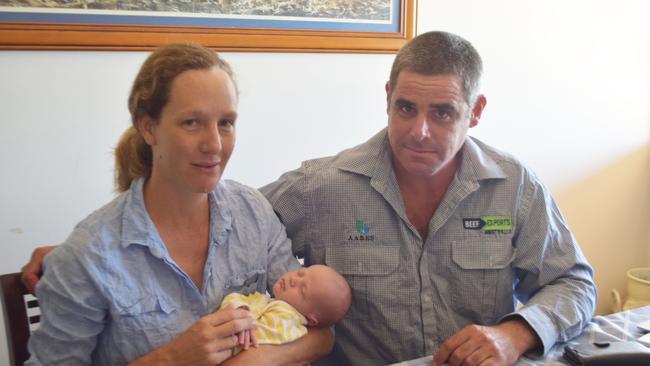
At a community meeting hosted by Darling Downs Hospital and Health Service to discuss ongoing issues with Chinchilla’s maternity service, a local suggested the service consider paying doctors more to attract and retain them.
“They said they didn’t want to set a precedent of doing that,” Mr Keating said.
“I don’t know how many times the Government needs to be told there’s a problem out here but it just doesn’t seem to sink in and nothing gets fixed.”
Some families have been forced to stay in Toowoomba, at their own expense, for a week or two before their due date to make sure they are close enough to appropriate services, Mr Keating said.

